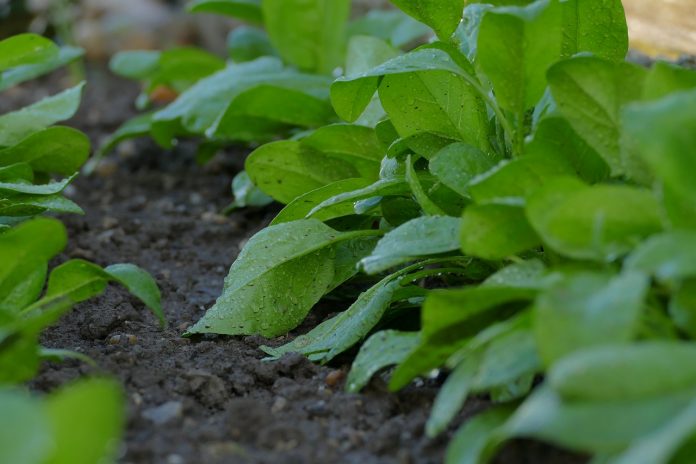1Root development
For vegetables, 70 percent of the soil moisture will come from the upper 50 percent of the effective rooting depth. This is where the largest fraction of active roots are found. Most vegetables have an effective root depth of 12-20 inches.
2Soil infiltration
Soil infiltration characteristics determine maximum water application rates. Your soil survey contains great information on water movement and retention specific to your property.
Tables describe how fast water moves through various soil types in inches per hour at different depths. It will also give the available water capacity as inches of water per inch of soil depth.
3Water holding capacity
The available water capacity is the difference between the total amounts of water the soil can hold just short of saturation down to the lower limit of the permanent wilting point. When the permanent wilting point is reached, the plant can no longer access the residual moisture as it becomes bound to soil particles.
4Maximum allowable depletion
This is the amount of available water capacity that can be depleted without hurting crop yield or quality. It is monitored in the effective rooting zone, and, for most crops, it is between 40-60 percent of the available water capacity. If your soil dries below that point for any period of time, the crop is at risk.
5Water budgeting
Water budgeting starts with an estimate of the available water capacity in the crop’s root zone. Irrigation should begin when the stored soil moisture approaches 50 percent of the available capacity or the plants will become stressed. Moisture content should be measured periodically to verify water use and moisture depletion estimates.
6Soil probe
The appearance of the soil after being squeezed by hand can be used to estimate water content. With experience, this method can be quite reliable, and charts are available to describe how different soils with different moisture content should look and feel.
A common mistake is to feel the soil on the surface rather than around the root tips, where most moisture is taken up. Use a soil probe to sample soil in the crop root zone.
Source: Irrigation for Fruit and Vegetable Production, Penn State Extension; Irrigation Management Basics, Oregon State University.
(Farm and Dairy is featuring a series of “101” columns throughout the year to help young and beginning farmers master farm living. From finances to management to machinery repair and animal care, farmers do it all.)
More Farming 101 columns:
- How to choose the right irrigation system
- Things to consider when burning agricultural waste
- What can you burn on the farm?
- 9 tips for better pasture management
- 7 safety tips for driving farm equipment on the road
- 5 things to know about farmland leases
- No-till planter in-field checklist
- How to prep a no-till planter part 2
- How to prep a no-till planter
- 7 considerations for gardening with high tunnels
- 9 basic considerations for backyard poultry
- 9 ways to grow your farm business
- 10 questions to ask before expanding the farm
- How to select quality replacement heifers
- Stay safe working with electricity on the farm
- How to create a job safety analysis
- Tips for a successful lambing season
- Do you have a vision for your farm?
- Cattle handling for beginners
- Should I buy a new or used tractor?
- How to inspect a used tractor before purchase
- How to buy the right tractor for your farm
- 5 tips for a better farm marketing plan
- How to seek help with retirement planning
- How to set goals for retirement
- A farmer’s guide to saving for retirement
- A farmer’s guide to planning for retirement
- 5 steps to get NRCS assistance
- How can conservation easements help you?
- How to fund conservation plans
- What is a conservation plan?
- How can NRCS help you?
- More airborne hazards on the farm
- 5 airborne hazards to beware of on the farm
- 5 things to know about Wagyu beef
- Pennsylvania utility vehicle laws
- Ohio utility vehicle laws
- Farm chemical safety checklist
- When should a farm become a business entity?
- Harvest prep: Check your yield monitors
- How to tag livestock properly
- 6 tips for decision making on a family farm
- 8 tips to prepare your farm for agritourism
- How to plan for farm emergencies
- 7 keys to success on the farm
- 7 tips for healthy fair animals
- 5 tips to ensure livestock health before the fair
- 6 tips to keep your livestock parasite free
- 6 tips for vaccinating your livestock
- 5 tips to prevent dairy cow foot problems
- 6 common foot problems found in dairy cows
- Recognize, prevent heat stress in dairy cattle
- How to monitor your dairy herd
- How to start your own dairy farm
- 5 tips for sun safety in the field
- Employing youth for the summer
- What to do if a hay fire occurs
- How to prevent hay fires
- How to extend the life of your fence
- 10 safety tips for installing electric fences
- How to chose the right fence for your farm
- How to create a fencing plan
- 7 steps for easy sprayer calibration
- Prepare for planting season, Part 2: Calibration
- Prepare for planting season, Part 1: The Basics
- 7 tips to improve security on your farm
- 5 tips to protect your farmland
- 3 measures to deal with severe farm debt
- How to buy time to catch up on farm debt
- 6 tips to manage income on the farm
- 5 tips to recognize and deal with farm stress
- How to prepare a livestock birthing kit
- 5 tips for marketing your farm
- How to develop farm mission, vision statements
- 5 tips for setting farm goals
- 2 types of livestock insurance policies
- 6 things you need to know about WFRP plans
- 3 basics of crop insurance
- How does liability insurance work on the farm?
- Why do I need farm insurance?
- How to understand and use Ohio’s CAUV
- How to utilize the Pa. Clean and Green Act
- 9 tips for filing farm taxes
- 8 reasons record keeping for taxes is essential
- 5 tips for post-harvest storage
- 7 tips for family meetings on the farm
- 4 tips for balancing your farm and family
- 4 tips for communicating on the family farm
- 4 tips for firing an employee
- 6 tips for keeping good farm help
- 4 tips for recruiting farm labor
- 5 general farm labor laws
- 4 tips for employing minors
- 4 tips for PTO safety
- 5 things young farmers should know about finances
- The farm balance sheet
- 5 items for your farm’s cash flow statement
- Personal and business records: Keep them separate
- What to include in your farm business plan
- How to approach a lender: Tips for getting a farm loan
- How to use microloans to get your farm started
- Saving for the future: 6 tips for young farmers
- How to create a farm safety kit
- 5 tips for child safety on the farm
- 4 tips for transporting livestock
- 5 ways to better understand tractor stability
- 6 farm equipment hacks













